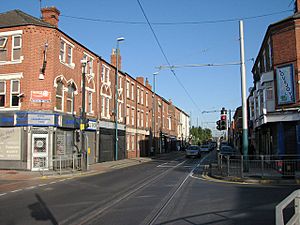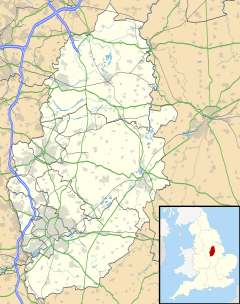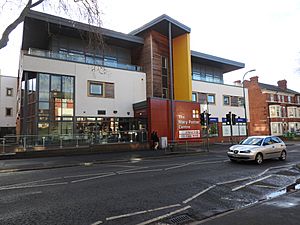Hyson Green facts for kids
Quick facts for kids Hyson Green |
|
|---|---|
 Junction of Radford Road and Berridge Road |
|
| District | |
| Shire county | |
| Region | |
| Country | England |
| Sovereign state | United Kingdom |
| Post town | NOTTINGHAM |
| Postcode district | NG7 |
| Dialling code | 0115 |
| Police | Nottinghamshire |
| Fire | Nottinghamshire |
| Ambulance | East Midlands |
| EU Parliament | East Midlands |
| UK Parliament |
|
Hyson Green is a lively neighbourhood in Nottingham, England. It's known for its many different cultures and a busy local economy. Hyson Green has the largest number of people from various ethnic backgrounds in Nottingham. Since 2006, the area has grown a lot, with more new buildings and money coming in from other countries than anywhere else in Nottingham.
Hyson Green covers parts of the Berridge and Arboretum areas of Nottingham. Even though the local economy is getting better, some families still face challenges.
The area is easy to get to by tram, with stops at Radford Road tram stop and Hyson Green Market tram stop. The tram system, called the Nottingham Express Transit, has made Hyson Green more well-known and helped to improve the area.
Contents
A Look at Hyson Green's Past
Hyson Green was built on what used to be a large, sandy open area with lots of gorse and heather. After the Norman Conquest, this land became part of William Peverel's estate. He was a chief helper to King William I.
A famous event happened here on October 19, 1330. King Edward III walked through this area with his men to arrest Roger Mortimer at Nottingham Castle. At that time, Hyson Green was known as High Sands.
The First Homes in Hyson Green
The first modern house in Hyson Green was built in 1802. By 1820, groups of workers, like stocking-makers, built rows of houses. These homes cost about £70 each, and the workers paid for them over time. The top floors of these four-storey houses were used as workshops for their knitting machines. These houses were quite big and had long front gardens. This was different from the smaller, more crowded homes being built in nearby areas.
A popular spot was the Cricket Players public-house, which opened around 1824. It had a tea garden and a bowling green for people to enjoy.
In 1869, the streets of Hyson Green got gas lights. By 1875, Hyson Green had several streets of houses. There was also a brass foundry and a lace factory. The area had an Anglican church with a school and two Methodist chapels. In 1877, Hyson Green officially became part of Nottingham. Many more houses were built around 1880.
By 1912, Hyson Green had many streets with small, closely packed terraced houses. The large gardens of earlier homes had been filled in with more cottages. Despite the crowded conditions, the community was very strong and supportive of each other.
Life in the Hyson Green Flats
The Hyson Green Flats were large apartment buildings constructed in 1965. They were a well-known landmark and many people enjoyed living there because of the strong community feeling. There were 593 homes, each with a kitchen, bathroom, and shared central heating.
Councillor Marcia Watson, who lived there, remembered:
High rise was popular then. People weren’t fussy back then. The view was beautiful. Absolutely beautiful. I loved it…for me, moving in and living there, it was the first home of my own.
These tall buildings were built by big construction companies. They had many high-level walkways to access the homes. Over time, some problems appeared with these buildings. By the 1980s, living in council-rented homes was not as popular as it once was.
Events in Hyson Green in 1981
In 1981, there were serious disturbances in several English cities, including Nottingham. These events happened between July 10 and 12. The main reasons for the unrest were tensions between different groups of people and problems in inner-city areas, along with a lack of trust in the police.
The events in Nottingham started on Radford Road. They then moved to the Hyson Green Flats. On the Saturday night, the unrest moved to the city centre. People used stones and petrol bombs, and some shops were damaged. However, residents of the flats successfully stopped an attempt to set the buildings on fire. Over 100 people were arrested by the police.
In 1982, Prince Charles visited Hyson Green Flats to learn about inner-city life. He walked around the walkways, drank tea, and talked with residents. He left in a yellow helicopter.
New Homes After the Flats
The Hyson Green Flats were taken down in 1988. The cleared land was then used to build a large Asda supermarket and new, smaller homes with fewer floors.
Hyson Green's Location
Next to The Forest tram stop is the Forest Recreation Ground. This large park hosts the yearly Nottingham Goose Fair and many sports matches. It also has a small playground. In Victorian times, this recreation ground was a race course.
Local services include a library, which is now inside the Mary Potter Centre. This centre is named after Mary Potter, who started a religious group called the Little Company of Mary in Nottingham. The old library building, from around 1890, was always a free library.
Local Shops and Places of Worship
Radford Road in Hyson Green is a very busy shopping street outside the city centre. In 2013, it had two large Asian supermarkets.
The area is home to many different places of worship. These include a Czech Republic Protestant Church, a Russian Orthodox Church, a Greek Orthodox Church, a Nigerian Catholic Church, two gurdwaras, three Hindu temples, a Buddhist temple, and eleven mosques.
- St Paul's Church, Hyson Green, now used for housing
- St Stephen's Church, Hyson Green
- Hyson Green Methodist Free Church, now a community centre
- St Mary's Roman Catholic Church
Getting Around Hyson Green
Nottingham City Transport (Bus routes)
- L12: University Campus – QMC – Hyson Green – City Hospital Island.
- L14: Nottingham – Canning Circus – Hyson Green – City Hospital – Basford – Bulwell.
Nottingham Express Transit (Tram lines)
| Preceding station | NET | Following station | ||
|---|---|---|---|---|
| Radford Road
towards Toton Lane
|
Line 1 | The Forest
towards Hucknall
|
||
| Radford Road
towards Clifton South
|
Line 2 | The Forest
towards Phoenix Park
|
||
- Tram: Nottingham – Hyson Green – Basford – Bulwell – Hucknall.
- Tram: Nottingham – Hyson Green – Basford – Phoenix Park.
Schools in the Area
The main secondary school nearby is the Djanogly City Academy. On the edge of the district are Scotholme Primary and Nursery School, the two Berridge Primary and Nursery Schools, and St Mary's RC Primary School in New Radford.
Well-Known People from Hyson Green
- Tom Blower (1914–1955), a famous swimmer born in Hyson Green.
- Peter Bowles (1936–2022), an actor.
- Fred Geary (1868–1955), a footballer for Everton and the England team, was born here. He started his career with Notts County.
- Ice MC (1965-), a Eurodance rapper.



